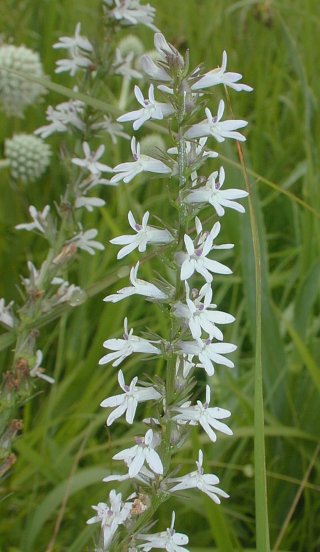 Description:
This perennial plant is ¾–2¼' tall and unbranched. It tends to
be short-lived. The central stem is often ridged or angular near the
inflorescence. The sessile alternate leaves occur primarily along the
lower half of the stem, and are up to 3½" long and 1" across. They are
usually lanceolate or narrowly ovate, but are sometimes wider at the
tip than the base. Their margins often have widely spaced teeth, but
are sometimes smooth. The inflorescence consists of a long spike of
flowers about 3-12" in length. The flowers are light blue or white, and
about 1/3" (8 mm.) across. Each flower has a smaller upper lip that is
divided
into 2 lobes, and a larger lower lip that is divided into 3 lobes.
There is a purple or dark blue stigma that is strongly exerted from the
upper part of the corolla tube, and bends downward at its tip. The base
of the flower consists of a tubular calyx with 5 teeth. Sometimes tiny
appendages (0-4 mm. in length) occur between the teeth of the
calyx. The blooming
period occurs during mid-summer and lasts about a month. There is no
noticeable floral scent. Later in the year, the flowers are replaced by
seedpods. The latter split open at the top, exposing numerous tiny
seeds that are easily carried by occasional gusts of wind. The root
system consists of a central taproot.
Description:
This perennial plant is ¾–2¼' tall and unbranched. It tends to
be short-lived. The central stem is often ridged or angular near the
inflorescence. The sessile alternate leaves occur primarily along the
lower half of the stem, and are up to 3½" long and 1" across. They are
usually lanceolate or narrowly ovate, but are sometimes wider at the
tip than the base. Their margins often have widely spaced teeth, but
are sometimes smooth. The inflorescence consists of a long spike of
flowers about 3-12" in length. The flowers are light blue or white, and
about 1/3" (8 mm.) across. Each flower has a smaller upper lip that is
divided
into 2 lobes, and a larger lower lip that is divided into 3 lobes.
There is a purple or dark blue stigma that is strongly exerted from the
upper part of the corolla tube, and bends downward at its tip. The base
of the flower consists of a tubular calyx with 5 teeth. Sometimes tiny
appendages (0-4 mm. in length) occur between the teeth of the
calyx. The blooming
period occurs during mid-summer and lasts about a month. There is no
noticeable floral scent. Later in the year, the flowers are replaced by
seedpods. The latter split open at the top, exposing numerous tiny
seeds that are easily carried by occasional gusts of wind. The root
system consists of a central taproot.
Cultivation:
The preference is full or partial sun and moist to slightly dry
conditions. Growth is best when the soil is rich and loamy, but it can
also be somewhat rocky. Some of the lower leaves may turn yellow and
fall off the stem during a drought. There is also a tendency for this
plant to flop over if it is spoiled with too much water or fertilizer
and lacks adequate support from adajacent plants. It is necessary to
keep the soil consistently moist in order to keep the small seedlings
alive.
Range & Habitat:
The native Pale-Spiked Lobelia occurs occasionally in the majority of
counties in
Illinois, but it is less common or absent in the SE portion of the
state (see Distribution
Map). Habitats include moist to mesic black soil prairies,
typical savannas and sandy savannas, moist meadows in woodlands or near
rivers, thickets, bluffs, limestone glades, and abandoned fields. This
is usually an understory plant whose inflorescence appears among the
taller grasses and forbs.
Faunal Associations:
The flowers attract long-tongued bees primarily, including little
carpenter bees (Ceratina
spp.), miner bees (Melissodes
spp.), mason bees (Osmia
spp.), and leaf-cutting bees (Megachile spp.).
Small butterflies and skippers also visit the flowers occasionally,
which are probably less effective at pollination. All of these insects
seek nectar. The leaves and stems contain a watery white latex that is
toxic, therefore most mammalian herbivores are less likely to eat this
plant than others. However, deer appear to be somewhat immune to the
effects of the toxins in the foliage. The seeds are too small to be of
any interest to birds.

Photographic
Location:
The photographs were taken at Loda Cemetery Prairie in Iroquois County,
Illinois.
Comments:
With its smaller pale flowers, Pale-Spiked Lobelia is less showy than
some of its better known relatives, such as Lobelia cardinalis
(Cardinal Flower) and Lobelia siphilitica
(Great Blue Lobelia), but it has better resistance to dry conditions
after becoming established. The flowers of these species all share a
similar structure, but vary considerably in their size and color.
Another species in this genus with small flowers, Lobelia kalmii
(Kalm's Lobelia), has more narrow leaves than Pale-Spiked Lobelia.
Across different populations of Pale-Spike Lobelia, there is some
variability in the color of the flowers, hairiness of the
foliage, and the length of the tiny appendages between the calyx
teeth.